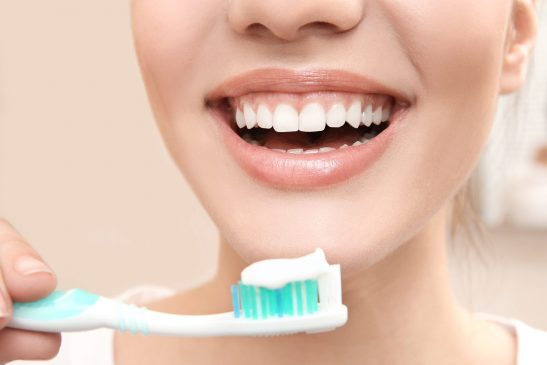The toothpaste theory claims that the small coloured square at the bottom of a toothpaste tube indicates its ingredients. Experts reveal if this theory is true.
In Short
- The toothpaste theory is going viral on the web
- It is woven around the ingredients found in this everyday essential
- A toothpaste tube with a green square apparently means it is made from only natural ingredients
Social media offers a wealth of opportunities to learn about virtually anything. However, the online world also harbours darker corners filled with various theories.
One popular example is the Simpsons theory, which suggests that the long-running sitcom has an uncanny ability to predict the future.
Another viral theory circulating on the Internet is the toothpaste theory, which is woven around the ingredients found in this everyday essential.
Also Read : Why investing in luxury real estate is a smart move for high returns?
In Short
- The toothpaste theory is going viral on the web
- It is woven around the ingredients found in this everyday essential
- A toothpaste tube with a green square apparently means it is made from only natural ingredients
Social media offers a wealth of opportunities to learn about virtually anything. However, the online world also harbours darker corners filled with various theories.
One popular example is the Simpsons theory, which suggests that the long-running sitcom has an uncanny ability to predict the future.
Another viral theory circulating on the Internet is the toothpaste theory, which is woven around the ingredients found in this everyday essential.
- If there is a green square, it means the toothpaste is made from only natural ingredients.
- A blue mark means it contains a mix of natural ingredients and medication.
- A red marking means that the product contains both natural ingredients and chemical ingredients.
- And, if your toothpaste has a black square, it means it contains only chemical ingredients.
The truth behind the toothpaste theory
“This theory is false,” Dr Vinod Tyagi, consultant, department of dentistry, Yatharth Super Speciality Hospital, Noida Extension, tells India Today.
The doctor explains that the coloured bars, known as ‘eye marks’ or ‘colour marks’, are used in the manufacturing process for packaging and cutting purposes. They help machines detect where to cut and seal the tubes and have no relation to the product’s ingredients.
Toothpaste ingredients are listed on the packaging, as mandated by regulatory authorities, and consumers should refer to this information for accurate details about the product.
Dr Sachin Deepak Mehta, a Mumbai-based dentist, agrees and says, “Contrary to popular belief, the small squares found at the bottom of toothpaste tubes do not indicate its composition or ingredients.”
He also mentions that these squares serve a practical function; they assist light sensors on tube-sealing machines in identifying the tube’s end. This ensures precise cutting and sealing of the tubes during manufacturing processes.
Further, Dr Tyagi shares that toothpaste typically contains several key ingredients, each serving a specific purpose:
- Humectants: Prevent the toothpaste from drying out (glycerin, sorbitol).
- Abrasives: Help remove plaque and stains from teeth (calcium carbonate, silica).
- Binders: Maintain the consistency of the toothpaste (xanthan gum, carrageenan).
- Sweeteners: Enhance the flavour without contributing to tooth decay (saccharin, xylitol).
- Flavouring agents: Provide a pleasant taste (mint, cinnamon).
- Detergents: Create foam to aid in cleaning (sodium lauryl sulphate).
- Fluorides: Strengthen tooth enamel and prevent cavities (sodium fluoride, stannous fluoride).
- Antibacterial agents: Help control plaque and gum disease (triclosan, zinc citrate).
All these ingredients work together to clean teeth, prevent tooth decay, freshen breath, and maintain overall oral health. Specific formulations may vary depending on the brand and the intended purpose of the toothpaste.
To figure out what ingredients are present in your toothpaste, you can check the ingredient list printed on the packaging. Moreover, the front or sides of the toothpaste packaging often highlight key features such as ‘whitening’, ‘fluoride’, ‘sensitive’, etc. These labels give you clues about specific ingredients or benefits the toothpaste offers.
Also Read : Are you claiming false HRA while filing ITR? This is how much it can cost you
Which one should you pick?
“There are several different types of toothpaste available, each designed to serve specific purposes and address various oral health needs,” says Dr Mehta.
Here are some common types of toothpaste and their purposes:
- Fluoride toothpaste: This is the most common type of toothpaste. Fluoride helps to strengthen tooth enamel and prevent tooth decay. It’s suitable for everyday use for both adults and children (under adult supervision).
- Whitening toothpaste: Whitening toothpaste typically contains mild abrasives or chemicals that help remove surface stains on teeth, making them appear whiter. They do not typically bleach teeth, but they can enhance the natural whiteness of teeth over time with regular use.
- Antibacterial toothpaste: Such products contain ingredients like triclosan or stannous fluoride that help reduce bacterial growth in the mouth. They are useful for preventing gum disease and controlling plaque buildup.
- Desensitising toothpaste: Designed for people with sensitive teeth, such toothpaste contains ingredients like potassium nitrate or strontium chloride that help reduce tooth sensitivity to hot, cold, or sweet foods and drinks.
- Tartar control toothpaste: Tartar (or dental calculus) forms when plaque hardens on teeth over time. Tartar control toothpaste often contains ingredients like zinc citrate or pyrophosphates that help prevent tartar buildup between dental cleanings.
- Natural toothpaste: Natural toothpaste is formulated with ingredients derived from natural sources and is free from artificial flavours, colours, or preservatives. They may appeal to those looking for more environmentally friendly or gentle oral care products.
- Children’s toothpaste: Toothpaste designed for children often has milder flavours and lower fluoride content (to minimise swallowing risks).
- Gum care toothpaste: These products are formulated to promote gum health, typically containing ingredients like stannous fluoride or herbal extracts that help reduce inflammation and bleeding gums.
- Smoker’s toothpaste: Specifically formulated for smokers, these often contain ingredients that help reduce staining and freshen breath more effectively than standard toothpaste.
- Sensitive teeth toothpaste: Similar to desensitising toothpaste, these products are designed to help alleviate tooth sensitivity by blocking the tubules that lead to the nerves inside the teeth.
- Herbal toothpaste: Herbal toothpaste contains natural extracts like mint, neem, or tea tree oil, which are believed to have antibacterial properties and provide a natural freshening effect.
Dr Mehta shares that it’s important to choose a toothpaste that addresses your specific oral health needs and preferences. Consult with your dentist if you have any concerns or if you’re unsure which type of toothpaste is best suited for you.
Also Read :
Also Read : How To Transfer Your PF From Exempted Trust To EPFO Online?
Let’s understand why is oral hygiene important?
- Prevention of dental issues: Regular brushing and flossing remove plaque, which is the leading cause of tooth decay and gum disease.
- Overall health: Poor oral hygiene has been linked to various systemic conditions, including heart disease, diabetes, and respiratory issues.
- Avoiding bad breath: Good oral hygiene helps prevent halitosis (bad breath), which can be a significant social concern.
- Aesthetic appeal: Clean, healthy teeth contribute to a bright smile and overall appearance.
- Adding to this, Dr Mehta says, “A consistent oral hygiene routine can significantly enhance self-esteem and confidence by ensuring fresh breath and a radiant smile. This, in turn, fosters better social interactions and may contribute positively to your professional life. Oral hygiene goes beyond mere dental care; it plays a pivotal role in maintaining overall quality of life and holistic well-being.”
- Now, here are some oral hygiene tips from experts
- Brush twice daily: Brush your teeth thoroughly twice a day with fluoride toothpaste. Use a soft-bristled toothbrush and brush in gentle, circular motions to clean all surfaces of your teeth and gums.
- Floss daily: Flossing helps remove plaque and food particles from between your teeth and along the gumline, where your toothbrush may not reach effectively. Make it a habit to floss at least once a day.
- Use mouthwash: Rinse with an antimicrobial mouthwash to help reduce plaque, prevent gum disease, and freshen your breath. Choose a mouthwash that contains fluoride for added protection against cavities.
- Maintain a balanced diet: Eat a balanced diet rich in fruits, vegetables, whole grains, and lean proteins. Limit sugary snacks and drinks, as sugar contributes to tooth decay. Drink plenty of water throughout the day.
- Visit your dentist regularly: Schedule regular dental check-ups and professional cleanings, typically every six months or as recommended by your dentist. Regular visits help detect dental issues early and prevent problems before they worsen.
- Replace your toothbrush regularly: Replace your toothbrush or toothbrush head every 3-4 months, or sooner if the bristles become frayed. A worn-out toothbrush is less effective at cleaning your teeth properly.
- Protect your teeth: Wear a mouthguard when playing contact sports to protect your teeth from injury. Avoid using your teeth to open packages or bottles, as this can cause chips or cracks.
- Practise proper techniques: Use the right brushing and flossing techniques to ensure effective cleaning without causing damage to your gums or enamel. Your dentist or dental hygienist can demonstrate proper techniques if needed.
- Be aware of oral health changes: Pay attention to any changes in your oral health, such as persistent bad breath, tooth sensitivity, or bleeding gums. Promptly consult your dentist if you notice any unusual symptoms.





































